 |
| Wake Up To Beauty |
 |
| View from the Park Lake |
To wake up in one of the most beautiful settings on earth is startling. I looked out the floor to ceiling glass doors in front of my giant bed strewn with rose petals and could see the rugged snow-covered peaks of Jade Dragon Snow capped Mountain as the sun rose over with another Wow moment. Apparently no one had seen the peaks in weeks, much rain and cloud cover keeping them out of sight, but today, the sun chose to shine. A good day, our guide Holly claimed.
We set off early from the exotic, one-storied, rambling Banyan Tree Resort with its pools of carp, giant weeping willows, and incredible views of the mountain. Our stop was a public park to die for – Black Dragon Lake Park. What an
 |
| With the Girls at the Park |
environment around a small lake. Visitors were going ga-ga taking fotos of themselves with the Jade Dragon mountain in view behind. It was a good omen. The pathways are cobbled (I wore my cobble shoes today, finally) and we too posed with the magic mountain (the sun had also shown for the first time in weeks in Beijing on the day I met Ai Weiwei the artist) and also beside three pretty girls in local Maio and Hui to the hilt costumes, and wandered through overhanging trees and touched the “Ma Jong Tree” whose bark was blocks like ma jong tiles – rub it if you want luck at ma jong, so we did – and suddenly we came to an easy
open space where a group of Tibetans in costume formed a big circle for a morning Taiche dance on one side, and a group of scattered old folks on the other side, some sitting, some standing – following a leader in facial massage for head muscle movements to keep from having strokes. This included squats, some leg shakes, hand wringing, knee rubbing, sinus pressure, head pressure points, rubbing face, rubbing eyes, pulling ears, massaging neck, massaging head points, – it gets you going. I joined in, although I was torn between the two.
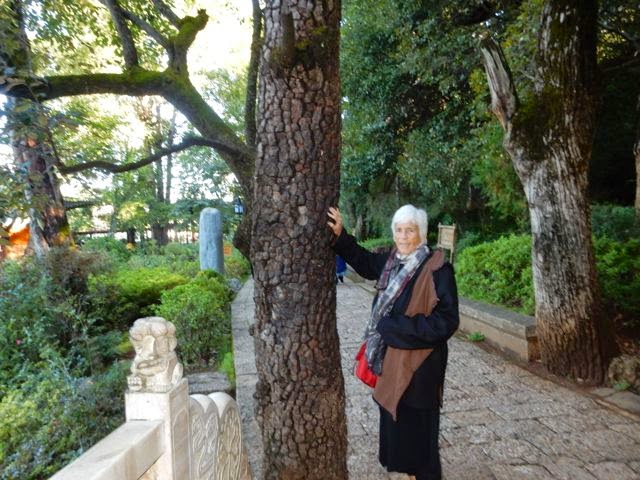 |
| Touching the Ma-jong tree |
 |
| Morning Movement |
What a great environment. We finally wandered further around the lake and could hear a symphony of birds all at once. Apparently, it is cricket for men to have bird cages with pet thrushes (singing birds) and they walk them to the park, hang them in a tree, then sit down with fellow males and share the day’s news while the birds sing back and forth to each other. There were probably a dozen hanging bamboo cages. And we continued to “aaahhh” at the mountain always in the distance, always in view, showing it’s snowy skin on this beautiful, cool fall day.
Close to the park was a museum where ancient manuscripts that survived the Cultural Revolution are being transcribed by a shaman. The Damong Culture which includes many minorities is fixed on a belief in animism and the wisdom and presence of ancestors. They worship the earth and the sky, and I can see why. They say the “borrow the landscape” to live in and must keep it holy. Fifty-seven per cent of the Naxi are of this faith and try to keep it alive, although the majority of their manuscripts and temples were crushed by Mao’s Cultural Revolution. Luckily, some of the manuscripts had been sent to Harvard University, others to the British Museum and some in Hamburg Germany, so all was not lost. Most of the rest that was not hidden, was burned by the troops. To the Damong, shamans are priests, fortune tellers and herbalist. It is a family thing: the grandfather to the father to the son is the way it is passed on. In 1999 at an international Damong festival there were 130 shamen, now only about 60 but their holy manuscripts are protected by UNESCO.
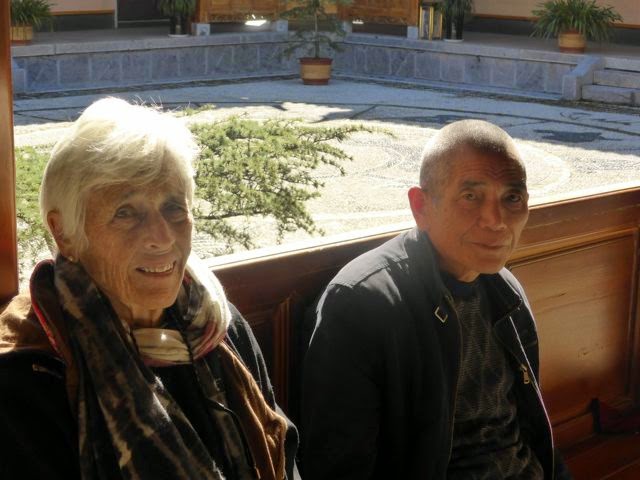 |
| Sharing with the Damong Shaman |
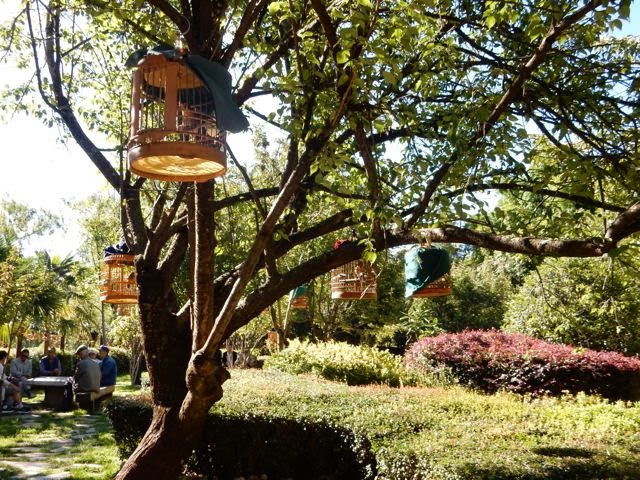 |
| Birds in tree, Men on bench |
An American Joseph Rock assisted in saving some of these papers so now the local shaman is translating them into Mandarin Chinese. That Damong shaman I had the pleasure to meet, (He is 73 to my 75) once performed 120 types of ceremonies, his son carries on 30 of them since he is only able to do four: 1) Worshiping Heaven, 2) Worshiping Earth, 3) Worshiping Nature and 4) Worshiping the Water Spirit, which is very important to them. The shaman often make sacrifices of fish and animals. Our translated conversation was about hope and peace and he presented me with an inscription in Naxi which he had written. (Naxi is the last pictographic language in use). We agreed that if we could all come together in peace and friendship no matter what our particular religion or philosophy, if we could quit being so critical and greedy for power, then the earth would survive, and we shared blessings with each other.
 |
| Impressions before the Mountain |
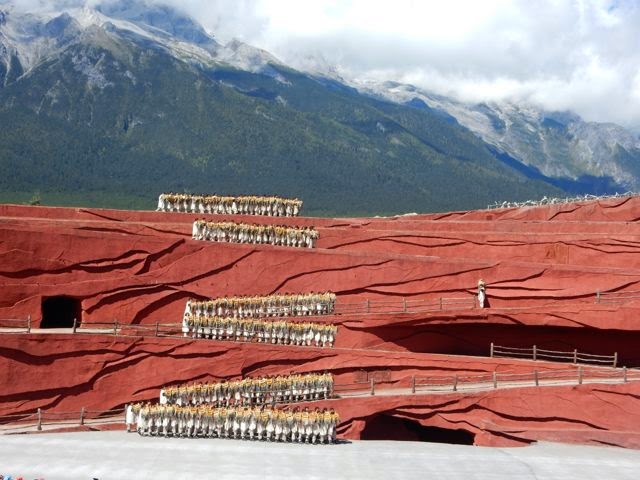 |
| Hundreds in Dance |
t was a perfect appetizer for what came next. We drove out of the city closer and closer to the Jade Dragon Mountain, in fact around one side of it, passing mani-pani stone offerings near the many small lakes (stones mounted upon stones for prayer – you pick a stone and from a distance toss it at the top – if it stays, a good fortune; if it falls back down, not so good.). And in the middle of nowhere, is another Impression extravaganza by the acclaimed Zhang Yimou (Beijing Olympics guy) but this one is the day time (i.e. decent photos) and this time the landscape is the spiritual Jade Dragon Snow Mountain. To boot, the sky was so blue it must have come from the stole of our Virgin Mary. There is a tall set with zig-zaging pathways and a bridge made of white and grey sticks. Every inch is put to use by the 500 performers and 200 horses. Truly, it is breathtaking.
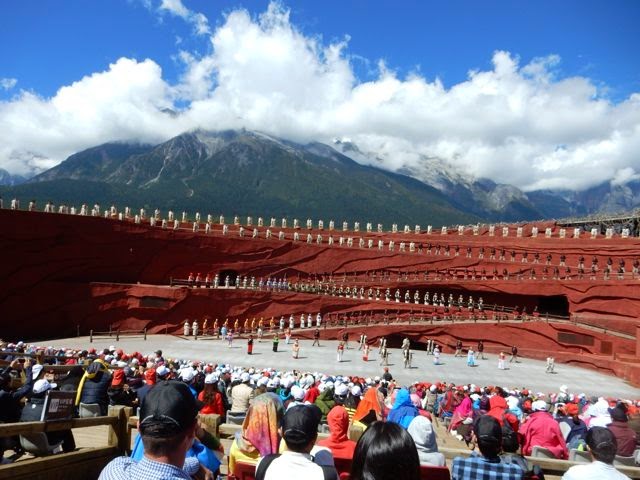 |
| God Smiled on Jade Mountain |
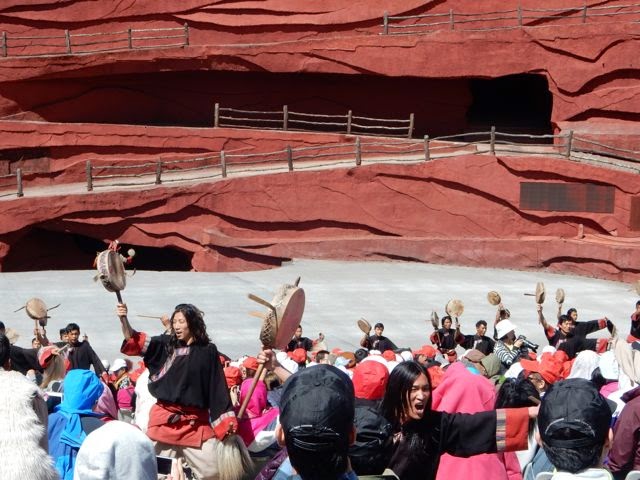 |
| Into the Crowds they Come |
The powerful drumming with flute and local instruments play typical music of the minority tribes, all accompanying a story about young love, with a table stomping segment when the men get dunk. Just the coming and working together of so many different tribal groups is miracle enough – Naxi, Yi, Tibetan, Bi, Pumi, Lisu, Miao, Mosuo – most are men in rough-hewn wool and fur outfits, all in boots, and the women are elaborately dressed in their tribal costumes. The steeds that canter along the top of the stage and around us are shaggy ponies, Mongolian type. The singing soars through the air like peace birds and one minute the cast is running behind you and the next is climbing the long pitches to the top of the set. The audience is mostly Chinese, there are 3 shows a day, but a few westerners were sprinkled in.
We sat in the top few rows and were given a black silk cap to keep the sun from roasting us. By the end of the performance, we were drawn into the spirit of the singing and waving and praying to the Jade Dragon Snow Mountain and all that surrounded us. The men’s strong choral groups claimed God Smiles on The Mountain. As I looked up into the blue sky, I felt a great peace because I knew my mother was near. It caught me off guard so the event was very emotional for me, as I had been warned by Holly. No one gets away without having some sort of spiritual experience.
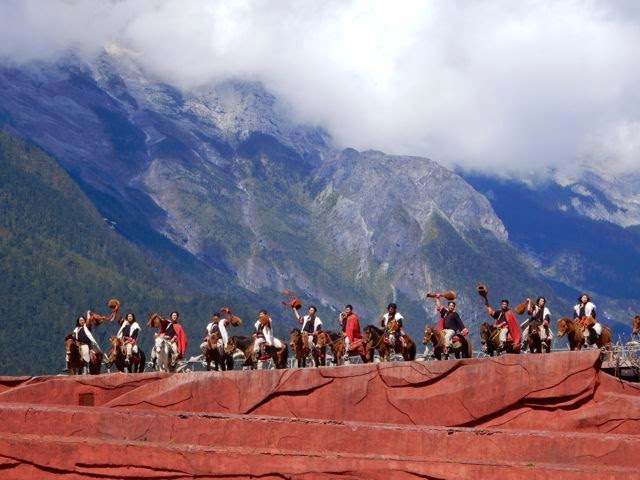 |
| Ponies at the Top |
 |
| Table Dancers |
As we drove back to town, we passed women in bright colors picking herbs and roots for medicinal purpose (Chinese). I’ve always believed God provides a cure in all his nature and that artificial chemicals only lessen our strengths. At 10,000 feet (on these mountains) there are at least 120 herbs that are useable, so the local tribes pick, clean an prepare them for market and make a bit of extra income. We did visit a Chinese herbal store in the Old Town where a strikingly young doctor prescribed a tea of snow mountain fungus to help get rid of my post-nasal drip. The process of making the tea is a wonder to behold – and all I can tell you is you need a bronze frog that the dirty water can be poured over (the herb must be cleansed a couple times with hot water.) I love these places because they are so unique. We found red saffron (very expensive) and the most expensive of all is corsedyps (dried worms casings) found up on these mountains. It is supposed to make your health brilliant ($100 for an ounce.)
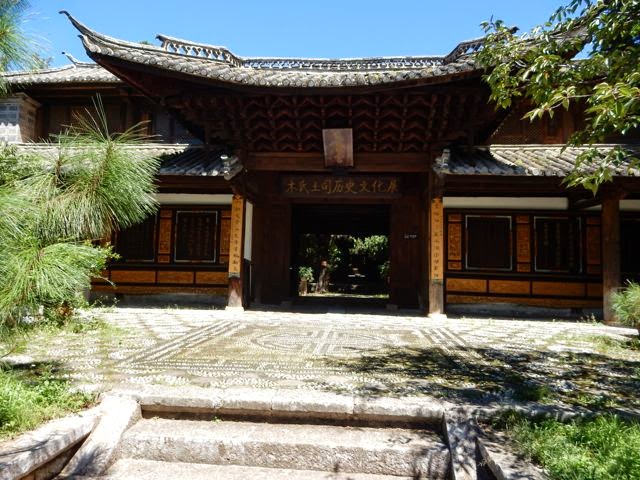 |
| Mu House |
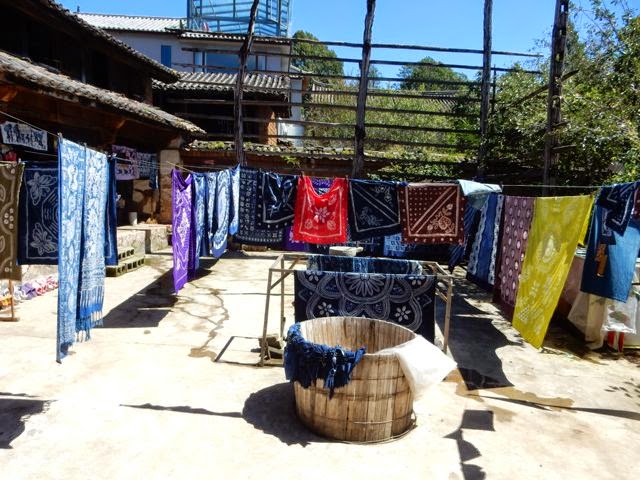 |
| Indigo Dying for Tribal Dress |
Believe it or not, the day was only half done. Back near the city, we passed the air strip where the Flying Tigers flew from during World War II. They’d never recognize it today. We reached the old village of Baisha, center of the area’s silk embroidery, for more than 500 years, and the streets are crumbled as backhoes dig up walking areas to install up to the date plumbing pipes. Silk embroidery has a 1500 year old history brought here by the Han migrants during the Ming Dynasty.
Step over a “ghost stop” panel into a traditional home or store and there is usually a spacious patio and garden and fascinating architectural delights. On the streets, in spite of dust and jack-hammers and other disturbances, venders offer every kind of embroidery, scarves, antique pick-me-ups, anything that could earn a rmb (Chinese money). We stepped into a family palace (don’t think big, but modest) constructed in the 16th century as home for the “Mu” ruling family to see a half dozen large murals which had been saved by the local people when the Cultural Revolution ravaged the town. Locals plastered over the treasures and then hung posters of Mao ZeDong over the top and somehow, the rampaging soldiers believed the trick and so the valuable Buddhist art works were saved. On resurrecting them again, some of the plaster damaged spots on the murals but truly, they are special. The place remains from the reign of the first king of Lijiang (Mu), said to be the child borne of a liaison between a Tang dynasty princess Wen Cheng (7th century) and the general of the Tibetan army sent to Xi’an to fetch her and escort her to Lhasa where she was to marry the great Tibetan king, Songsten Gambo. Like all histories, there are a thousand legends. We were standing where one happened.
 |
| Embroidering with a Student |
From here we visited Bai Sha Village Embroidery Academy and Workshop – since needlecraft was one of the reasons for this lengthy trip – and what a treat was in store. Although a young student showed me around and gave me a lesson in the basic stitches of their embroidery (never seen such a thin needle with such a tiny eye), and I pulled a few threads trying to not mess up her work, which she was allowing me to practice on, and she kept saying “very clever” as I chose where to put the long stitches. I had to laugh. Then her Master Teacher, (takes a minimum of 3 years to become a master), one of the stars of the academy, came to see and give me more information about various stitches. She allowed me to sit in front of two of her masterpieces in progress and showed me how to make flower stitches, and knots and other things similar to needlepoint, but much finer and harder. The finished pieces of embroidery art from this workshop were some of the most unique that I have seen in all the “shops” we have been through.
Although his forte is block printing, the head designer of the art work the students and masters interpret, also came to shake hands and when we said we were off to learn ma-jong, a broad smile crossed his face. He is a master of ma-jong
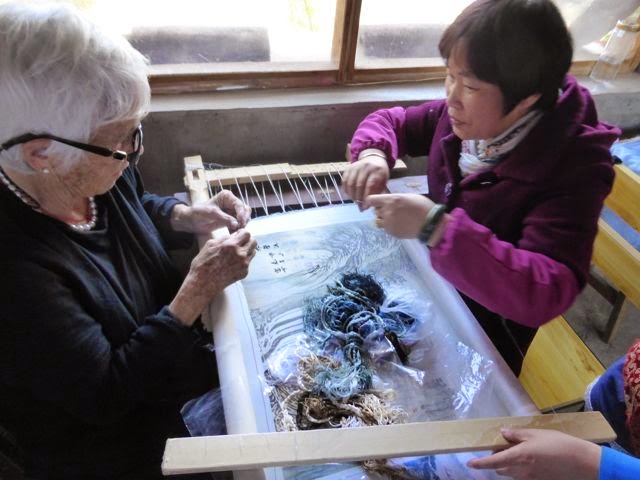 |
| Learning from the Master |
 |
| Ma Jong – The Table |
too. So when Holly took us to a private home of a friend who “loves” to play ma jong, as do most Chinese people – it’s a passion everywhere – the ma-jong master insisted he wanted to help. So we had two teachers and an expert lady around the table. Now the table is what did it for me. It is a square normal card table but in the center is a electronic dice thrower which determines who goes first and where the first draw of the tiles will be. I didn’t see any tiles and wondered when they appeared. Push of a button, and everyone’s set of tiles rises up from under the table already stacked and lined up perfectly. (They had been electronically shuffled and put into place. Wow!). Learning hard and after four games, slowly so I could get it right, I felt we had a small idea of the fun. Everyone laughs and enjoys. Usually money is involved, but we are amateurs. Now if I can just find three ma-jong players in Memphis…….and that table!
As we crawled across stone and rock and through dirt to get back to our trusty van, I was charged up by this day’s experiences. Last night Holly had taken us to the Old City markets which are so entertaining. Lots of jade (it’s jade country), silver is 99 per cent silver but not sterling, woven shawls, machine embroidered bags and baby-carriers, Mandarin dress and shoes, combs made of bone, Chinese zodiac figures and silver eating bowls that come with silver
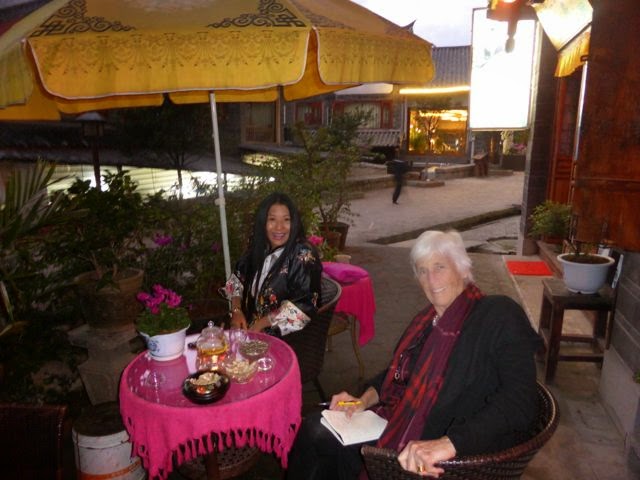 |
| Interviewing Namu |
chopsticks and soup spoon, silver knives, antiques – the shops were absolutely filled with shoppers at dusk into the dark hours. Tonight, we are scheduled to dine with the famous Muoso woman Namu, whom we had met in Beijing and is internationally known as a singer and one of the last of the matriarch queens who does not believe marriage is the answer. She has no children, and a fascinating history, being the first woman to desert her hometown, at age 13, and to set out to seek fame and fortune. Yunan Province is her homeland and here in the Old Town she has a famous bar/dining space, small, intimate, decorated with paintings of her, and extreme art and giant pillows and sofas in glorious fabrics. She welcomed us with sunflower seeds and white mountain tea in tiny glass cups. Then on the large low table in the dining area was a Hotpot dinner that wouldn’t end. She fed vegetables and other exotic foods into the boiling broth which had an amazing taste, and I had my first confrontation with Sichuan pepper (it tingles on the tongue but doesn’t burn). We also sampled her own homemade Shangri-la red wine and framboise ice wine (i.e. champagne) and a special end of the dinner drink, Namu’s flower drink, created from mint, lemon, fresh orange juice and Mama’s tears (corn liquor). Well, I only took a sip.




















Audrey,
Your photo of the pagoda with Jade Dragon Snow Mountain behind it is spectacular. Absolutely gorgeous and no doubt God did smile on this holy mountain. This is one you should enlarge and frame.
You said rose petals were strewn all over your bed. Who put the petals there?
We are always seeking good luck and good health.
Maybe you need to grow a Ma Jong Tree in your yard. Even though the luck from rubbing this tree is supposed to apply to ma jong, maybe somehow it will help in other areas. As far as throwing stones for luck, we gave that a try and our’s always fell to the bottom.
As you know, we have had health problems for a long time. However, even though dried worm casings are supposed to give you brillant health, we aren’t going there.
We did fairly well with the facial massage for head muscle movements until we got to the squats and ear pulling. We would squat and then we couldn’t get up! The ear pulling hurt and we won’t try that again. Guess we’ll just continue with our traditional treatments that aren’t working very well.
Continue to enjoy your adventure and please be safe. We pray God will watch over you and protect you with every step you take.
We miss you and love you very, very much,
Geraldean and Judge